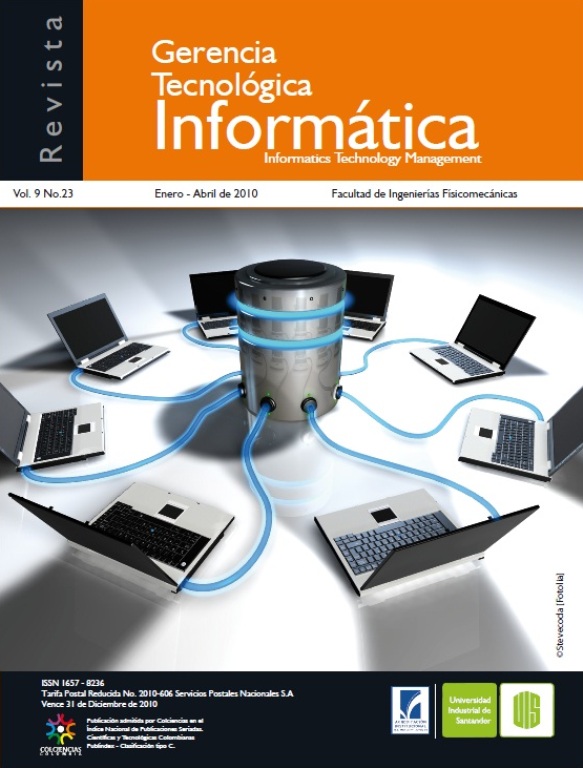Artículos
Publicado 2011-01-25
Cómo citar
Carrascal Reyes, M. C., & Calderón Cortés, O. J. (2011). TENDENCIAS EN LA INTERCONEXIÓN DE REDES DE NUEVA GENERACIÓN. Revista GTI, 9(23), 75–85. Recuperado a partir de https://revistas.uis.edu.co/index.php/revistagti/article/view/1355
Resumen
RESUMEN El contexto actual de evolución de las redes de comunicaciones tiende hacia la convergencia, un concepto que busca que todos los servicios de telecomunicaciones se soporten sobre una única infraestructura, garantizando a su vez los requerimientos de calidad de cada uno de ellos. En el ámbito de los servicios y las redes de telecomunicaciones existen muchos operadores que tienen portafolios de servicios, infraestructuras, y políticas de negocio diferentes; es en este escenario donde la interconexión de Redes de Nueva Generación (RNG) tiene relevancia. El presente artículo realiza un análisis y explora las opciones para interconexión de RNG definidas por organismos de estandarización, sus ventajas y factores técnicos determinantes, lo cual contribuirá a complementar el trabajo que en este aspecto viene realizando la Comisión de Regulación en Comunicaciones de Colombia (CRC). PALABRAS CLAVES: Redes de Nueva Generación, Convergencia, Modelo de Interconexión.ANALYTICAL SUMMARY The current evolution of networks tends towards convergence, a concept that attempt that all telecommunications services can be supported on the same infrastructure ensuring their individual quality of service requirements. In the telecommunication networks exists many operators each one having different services portfolios, infrastructure, business models and administrative rules. In this scenario is where the interconnection of New Generation Networks (NGN) is relevant. This article analyzes and explores options for interconnection of NGN as defined by standardization bodies, their advantages and technical factors. This paper contribute to complement the work that is been doing by the Communications Regulation Commission of Colombia. KEYWORDS: Next Generation Networks, Convergence, Interconnection Model.
Descargas
Los datos de descargas todavía no están disponibles.
Referencias
- ITU. “General overview of NGN” (2004). ITU-TRecommendation Y.2001.
- ITU. “General principles and general referencemodel for Next Generation Networks” (2004).ITU-T Recommendation Y.2011.
- Cochennec, J.-Y., «Activities on next-generationnetworks under Global Information Infrastructurein ITU-T,» Communications Magazine, IEEE ,vol.40, no.7, pp.98-101, Jul 2002
- Chae-Sub Lee; Knight, D., «Realization of the nextgeneration network,» Communications Magazine,IEEE , vol.43, no.10, pp. 34-41, Oct. 2005.
- ETSI. “Telecommunications and Internetconverged Services and Protocols for AdvancedNetworking (TISPAN); NGN Release 1; Releasedefinition” (2006). ETSI TR 180 001 V1.1.1
- ITU. “Supplement on NGN release 1 scope” (2006).ITU-T Suplemment 1 to Series Y Recommendation
- Knightson, K.; Morita, N.; Towle, T., «NGNarchitecture: generic principles, functionalarchitecture, and implementation,»Communications Magazine, IEEE, vol.43, no.10,pp. 49-56, Oct. 2005
- ITU. “Requisitos y arquitectura funcional de lasredes de la próxima generación, versión 1” (2006).ITU-T Recommendation Y.2012.
- ITU. “NGN release 1 requirements” (2007). ITU-TRecommendation Y.2201.
- Ericsson, “IMS – IP Multimedia Subsystem. Thevalue of using the IMS architecture,” 2004. [EnLínea]. Disponible: http://www.citmo.net/library/Ericsson%20IMS.pdf
- Ahson, S., Ilyas, M., IMS handbook, Taylor &Francis Group, 2009.
- Russell, T., The IP Multimedia Subsystem, McGrawHill, 2008.
- Telecommunications Services: Reference Paper, 24April 1996. [En línea] Disponible: http://www.wto.org/english/tratop_e/serv_e/telecom_e/tel23_e.htm
- ITU. “NGN release 1 requirements” (2007). ITU-TRecommendation Y.2201.
- Rochdi ZOUAKIA. “NGN interconnection:technology challenges”. ITU/BDT Arab RegionalWorkshop on « NGN Interconnection» Manama.Kingdom of Bahrain, May 02 -03 2007.
- ETSI. “Telecommunications and Internet convergedServices and Protocols for Advanced Networking(TISPAN); NGN Functional Architecture” (2008).ETSI ES 282 001 V2.0.0.
- 3GPP. Inter-IMS network to network interface. TR29.865
- 3GPP TS 29.162.
- 3GPP TR 29.863.
- 3GPP and TISPAN Gap Analysis of NGNInterconnection of Services. IP InterconnectMeeting. Sophia Antipolis. Telefónica Spain,Telecom Italia. 2008.
- GSMA PRD IR.34. “Inter-Service Provider IPBackbone Guidelines”
- GSMA PRD IR.65 “IMS Roaming & InterworkingGuidelines”
- Inter-IMS Network to Network Interface. 3GPP.3GPP TR 29.865. V0.2.0. 2007
